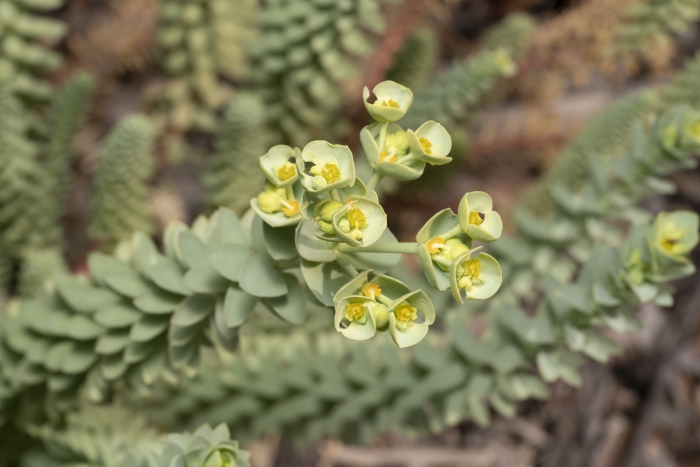Sea Spurge
(Euphorbia paralias)
Sea Spurge (Euphorbia paralias)
/
/

Eleftherios Katsillis
CC BY 4.0
Image By:
Eleftherios Katsillis
Recorded By:
Copyright:
CC BY 4.0
Copyright Notice:
Photo by: Eleftherios Katsillis | License Type: CC BY 4.0 | License URL: http://creativecommons.org/licenses/by/4.0/ | Rights Holder: Eleftherios Katsillis | Publisher: iNaturalist | Date Created: 2021-05-07T10:23:58-07:00 |

























Estimated Native Range
Summary
Euphorbia paralias, commonly known as sea spurge, is a glaucous perennial herb native to coastal dunes and sandy shores of Europe, northern Africa, and western Asia, and has become widely naturalized in Australia. It typically grows up to 28 inches tall with a bushy habit, featuring many stems and crowded, fleshy, blue-green leaves that contribute to its drought tolerance. The plant blooms with solitary cyathia, which are small, cup-like structures containing the flowers, surrounded by showy, yellowish bracts that may appear to be petals from a distance. Flowering occurs from late spring to early fall, and while the flowers are not particularly showy, they do attract a variety of insects.
Sea spurge is valued for its ability to thrive in challenging coastal environments, stabilizing sand and reducing erosion. It is often used in coastal restoration projects for this reason. In cultivation, it requires well-drained sandy soil, full sun, and minimal water once established, making it a low-maintenance choice for xeriscaping or seaside gardens. However, gardeners should be cautious as Euphorbia paralias contains a milky sap that is toxic and can cause skin irritation upon contact. It is potentially invasive outside its native range, and its ability to displace local species should be considered before planting.CC BY-SA 4.0
Sea spurge is valued for its ability to thrive in challenging coastal environments, stabilizing sand and reducing erosion. It is often used in coastal restoration projects for this reason. In cultivation, it requires well-drained sandy soil, full sun, and minimal water once established, making it a low-maintenance choice for xeriscaping or seaside gardens. However, gardeners should be cautious as Euphorbia paralias contains a milky sap that is toxic and can cause skin irritation upon contact. It is potentially invasive outside its native range, and its ability to displace local species should be considered before planting.CC BY-SA 4.0
Plant Description
- Plant Type: Herb
- Height: 1-3 feet
- Width: 1-2 feet
- Growth Rate: Slow
- Flower Color: Green, Yellow
- Flowering Season: Summer
- Leaf Retention: Deciduous
Growth Requirements
- Sun: Full Sun
- Water: Low
- Drainage: Fast
Common Uses
Drought Tolerant, Erosion Control, Low Maintenance
Natural Habitat
Coastal dunes and sandy shores
Other Names
Common Names: Молочай Прибережний, Sand Spurge
Scientific Names: , Euphorbia paralias, Esula paralias, Esula paralias, Euphorbia malacitana, Euphorbion paralium, Galarhoeus paralias, Tithymalus maritimus, Tithymalus paralias,
GBIF Accepted Name: